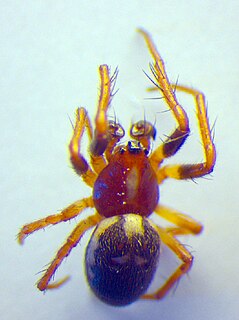
Dwarf sheet spiders (Hahniidae) is a family of araneomorph spiders, first described by Philipp Bertkau in 1878. Their bodies are about 2 millimetres (0.079 in) long, and they build extremely delicate webs in the form of a sheet. Unlike many spiders the web does not lead to a retreat. The silk used in these webs is so fine that they are difficult to spot unless they are coated with dew. They greatly favor locations near water or near moss, and are often found in leaf litter and detritus or on the leaves of shrubs and trees.

Tegenaria parietina is a rather rare spider in Europe, with a distribution also including Northern Africa to Central Asia and Sri Lanka, and from the West Indies to Uruguay and Argentina, where it may be introduced. In the UK it is sometimes known as the cardinal spider because of the legend that Cardinal Wolsey was terrified by this species at Hampton Court, or, conversely, because he regarded them as lucky and forbade anyone to harm them. In 2013, Tegenaria taprobanica was included in this species.

Uperodon taprobanicus, also known as the Sri Lankan bullfrog, Sri Lankan painted frog, Sri Lankan kaloula, Ceylon kaloula, Indian painted frog, or painted globular frog, is a species of narrow-mouthed frog found in Nepal, Bangladesh, southern and eastern India, and Sri Lanka up to an altitude of about 1300 metres. It can grow to an adult length of up to 75 millimetres(7.5 cm) long from snout to vent. It was originally described as a subspecies of Kaloula pulchra, ssp. taprobanica. The IUCN lists it as being of "Least Concern".

Hypsosinga is a genus of orb-weaver spiders first described by Anton Ausserer in 1871. The genus name is derived from the Greek "hypso", meaning "high", referring to the higher clypeus than those of the genus Singa.
Neoheterophrictus madraspatanus is a species of spider in the family Theraphosidae, found in India.
Argiope taprobanica is a species of spider of the genus Argiope. It is endemic to Sri Lanka.
Hypsosinga taprobanica, is a species of spider of the genus Hypsosinga. It is endemic to Sri Lanka.
Ariadna taprobanica is a species of spider of the genus Ariadna. It is endemic to Sri Lanka.
Alistra radleyi is a species of spider of the genus Alistra. It is endemic to Sri Lanka.
Alistra is a genus of dwarf sheet spiders that was first described by Tamerlan Thorell in 1894.
Alistra stenura, is a species of spider of the genus Alistra. It is endemic to Sri Lanka.
Speocera taprobanica is a species of spider of the genus Speocera. It is endemic to Sri Lanka.
Gamasomorpha taprobanica, is a species of spider of the genus Gamasomorpha. It is endemic to Sri Lanka.
Janula taprobanica, is a species of spider of the genus Janula. It is endemic to Sri Lanka.
Janula is a genus of comb-footed spiders that was first described by Embrik Strand in 1932. It is a senior synonym of Monetoculus.
Kapanga is a genus of South Pacific dwarf sheet spiders that was first described by Raymond Robert Forster in 1970.
Neoaviola is a monotypic genus of Australian dwarf sheet spiders containing the single species, Neoaviola insolens. It was first described by Arthur Gardiner Butler in 1929, and has only been found in Australia. It might be a synonym for Rinawa.
Scotospilus is a genus of dwarf sheet spiders that was first described by Eugène Simon in 1886.



